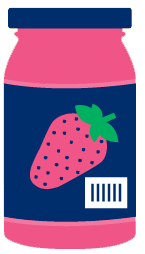GS1 Data
The finished product fields are used to define the five levels of the GS1 logistics hierarchy.
- The product, the EAN code and the Packaging section of the product are filled in
- The innner packaging, the EAN code in packaging and the In packaging section of the product are filled in, the field Number of product / in packaging indicates the number of products in the packaging pack:palletProductsPerInnerPack
- The case, the parcel EAN code is filled in, the logistics unit section is filled in. The packaging list allows you to indicate the number of products in the package or manually by entering (Number of products / package)
- The pallet, the pallet EAN code is filled in, the palletization section is filled in. The number of packages per pallet comes from the pallet kit or is entered manually (Number of packages / pallet)
- Transportation, the business unit type field is Transportation unit
When it is not possible to define all the logistics levels on a single product, it is necessary to create logistics variants. A logistics variant is a finished product where the field type of business unit is different from empty or Consumer unit - Basic unit.
The type of business unit field allows you to choose the type of logistics hierarchy described in the logistics variant. The business data applies to the type of business unit selected or to all if nothing is selected.
When a business unit type is selected the following default values apply to the other logistics levels defined in the product
- Billable Unit: No
- Controllable unit: No
- Consumer Unit: No
- Is a service: No
Example of a typical logistics setup:
| Type | Description | Attributs |
|---|---|---|
 EACH EACH |
The EAN code of the product is entered. The Packaging/Packaging section of the product is used to describe the packaging of the unit. Type of commercial unit: Consumer unit - Basic unit (optional) |
EAN: bcpg:eanCode Type of packaging / packaging: gs1:packagingTypeCode Height (mm): gs1:depth Width (mm): gs1:width Depth (mm): gs1:height Net Weight (kg): bcpg:netWeight Net Weight drained (kg): bcpg:drainedWeight Gross weight (kg): gs1:weight |
 INNER_PACK INNER_PACK |
Type of trade unit: Consumer batch - Homogeneous or heterogeneous logistics sub-packaging (optional) | EAN inner pack: gs1:innerPackEanCode Depth (mm): gs1:innerPackDepth Width (mm): gs1:innerPackWidth Height Pallet (mm): gs1:innerPackHeight SC Net Weight (kg): gs1:innerPackNetWeight SC Gross Weight (kg): gs1:innerPackWeight |
 CASE CASE |
The package EAN of the product is filled in. The Packaging/Logistics unit section of the product is used to describe the packaging of the unit. Type of trade unit: Standard homogeneous package (optional) |
EAN case: bcpg:eanCodeLevel2 Type of logistics unit: gs1:secondaryPackagingTypeCode Depth (mm): gs1:secondaryDepth Width (mm): gs1:secondaryWidth Height (mm): gs1:secondaryHeight Package net weight (kg): gs1:secondaryNetWeight Weight gross package(kg)::secondaryWeight |
 MIXED_CASE MIXED_CASE |
Requires creating a logistics variant composed of several finished products Type of business unit: Standard heterogeneous package (mandatory) |
|
 PALLET PALLET |
The EAN Palette of the product is filled in. The Product Packaging/Palletization section describes the palletization of the unit. Type of commercial unit: Pallet - standard homogeneous pallet box (optional) |
EAN pallet: bcpg:eanCodeLevel3 Depth (mm): gs1:tertiaryDepth Width (mm): gs1:tertiaryWidth Pallet height (mm): pack:palletHeight Pallet net weight (kg): gs1:tertiaryNetWeight Gross pallet weight (kg): gs1:tertiaryWeight Type of pallet support:** gs1:palletTypeCode |
 MIXED_PALLET MIXED_PALLET |
Requires creating a logistics variant composed of several finished products Type of business unit: Pallet - standard heterogeneous pallet box (mandatory) |
|
 DISPLAY_SHIPPER DISPLAY_SHIPPER |
Requires creating a logistics variant composed of several finished products Type of commercial unit: Pallet - standard heterogeneous pallet box (mandatory) Filled display: Yes (mandatory) |
hasDisplayReadyPackaging, DisplayTypeCode: Shelf Display / Floor Display |
 CASE OF EACH CASE OF EACH |
The EAN code of the product is entered: it contains the EAN code of the package |
In order to represent the five levels of the supply chain in beCPG, it is good practice to start with the smallest possible product and then work your way up using it as a component for the higher level product. Compared to the example above, we first define the consumer-level unit, then a pack-type product itself composed of several basic products, and so on up to the pallets.